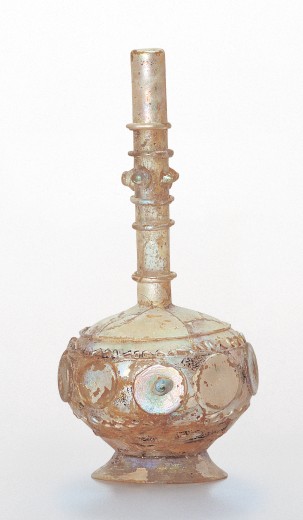 Print Page
Print Page
 Print Page
Print Page
Location: Iran
Materials: colourless glass with a greenish-yellow tinge and opaque turquoise prunts; blown, trail-decorated and tooled
Dimensions: 22.6 x 10.5cm
Accession Number: GLS 182
Other Notes:
The flask belongs to a small group of vessels decorated with applied discs that appear to be a revival of the imitations of luxury relief-cut vessels known from the Sasanian and the early Islamic periods. Although the application of the discs was clearly laborious – each of the discs was gathered separately, flattened on the marver and then quickly applied to the surface of the bottle – it still required a fraction of the time required to cut the same design from a thick-walled glass blank. Nevertheless, the expertise required to produce the results seen on this flask is formidable. The manipulation of trails into a variety of patterns, the addition of discs and prunts and, subsequently, the application of all of these elements to the surface of the vessel, require multiple skills seen in few other trail-decorated objects [see GLS 330].
The almost perfectly cylindrical neck and the squashed, globular body resting on a flared foot are reminiscent of contemporary, or slightly earlier, metal forms, which may also be decorated with circular medallions. The horizontal trails decorating the neck recall the flanges seen on the necks of metal flasks.
The neck is decorated with four horizontal trails, two above and two below a band of five conspicuous prunts. The shoulders are undecorated, but the body has a central register with nine applied discs, every third one of which has a turquoise prunt. Above and below are paired trailed bands, the outer ones plain and the inner ones with a zigzag pattern. The flaring foot is blown on, and the kicked underside retains a pontil mark.
Bibliography:
S.M. Goldstein et al, Glass. From Sasanian Antecedents to European Imitations, The Nasser D Khalili Collection of Islamic Art, volume XV, London 2005, cat.294, pp.255–6.
